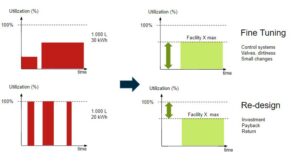Originally posted on 2018
Fine tuning or redesign? Part 1.
Prioritizing saving potentials.
When setting priorities in the search for savings potentials there are several quick tools and approaches that can help us: fine tuning or redesign. We can try to represent the efficiency of the systems and see if they are in areas far from the optimum.

Efficiency zones.
Most systems and equipment are governed by the below graph (pumps, fans, etc.). The power consumed is a linear function with respect to the utilization only in an ideal case. Ideal only when the use is zero or at the maximum use. In the rest of the zones there are many energy inefficiencies for various reasons (loss from engines, from motors, etc.). The normal situation is that we find ourselves in non efficient areas in our work. One way to smooth the real curve is by means of variable speed drives. But this is only a jam, not a sustainable solution in many cases. A proper design and a good operation with the equipment must be done. If this is not the case, if it is over sized or inadequately operated, we will find ourselves in the area of inefficiency.

Two examples of different performance.
I will try to explain the situation with a graphic of 2 facilities that perform the same function. In the upper left we have an installation that works improperly. When it works, it does in inefficient areas and its consumption is bigger than ideal. Therefore, throughout the working cycle the total sum of consumption is higher than expected. On the other hand, at the bottom left, we have an installation that works at the appropriate point. The equipment or the system only has two working positions: stopped or at the maximum load. They could be two facilities with a centrifugal pump that elevates the same amount of water but with different consumption.
How to fix inefficiency: fine tuning or redesign.
The solution depends on the degree of inefficiency of the system or the equipment. If the inefficiency is small it is enough with a fine tuning. It is obtained by means of a better regulation, change of some elements of regulation, and, in general, a small investment. However, if the inefficiency is very large, the problem is more complex. Thus, a fine adjustment is not enough, but it is a waste of time and resources. In these cases it is better to think about a redesign of the installation or the equipment.

Circles of efficiency.
Represented in another way, by means of circles, where the axis of the abscissa is the efficiency which we have in our installation or equipment. The inner circle represents low inefficiency and the solution is a fine tuning. However, if our installation is outside this small circle we are in a very inefficient area and we have to think about a redesign.
To execute this analysis, the theoretical characteristics of the equipment or system can be used. These data sources to determine if there is a very large inefficiency. Although the usual is to measure what is the real behavior of the equipment. You can create an equipment inventory. Then make a graph to represent them based on their efficiency. This way you can quickly determine the differences and what strategy is the one that must be applied.
If you want to see a practical example of the break even point between fine tuning and redesign go to the next post: break even point.
